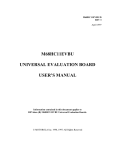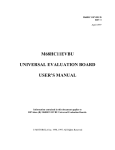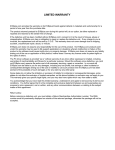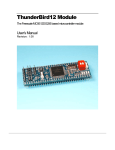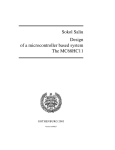Download Lab 1 : Introduction to the MC68HC11
Transcript
ELE 205 Lab 1 – Spring 2005 Lab 1 : Introduction to the MC68HC11 Read Chapters 1 and 2 and pages 4-1 through 4-29 of the Evaluation Board User’s Manual. It will be helpful to print out the BUFFALO Quick Reference chart (available on the ELE 205 web page) and bring it to lab. The M68HC11 evalutation board communicates with the PC via a serial cable. Make sure you understand how the board is powered and communicates with the PC. Have your TA check your connections before you get started. Port P2 on the board thinks that it is connected to a terminal, so we must run software on the PC that acts like a terminal. This is in the ELE 205 section of the desktop on the PC. After the system is started, you should see the following printed on the screen: ‘EVBplus.com: BUFFALO 3.42 - Bit User Fast Friendly Aid to Logical Operation’ BUFFALO Monitor Commands: Our microcontroller uses Random Access Memory (RAM) and if you pull the power plug, all information entered will be lost. The user RAM is in three address locations: at $0000 – $002C, $0100 – $01FF, and $8000 – $DFFF. This last range gives us 24 KB of user memory (more than enough for our course work). Note that BUFFALO expects all numbers entered hexadecimal format, so you should to review this number system (Appendix F in the textbook). Do not prepend the dollar sign ($) when typing hex numbers in BUFFALO. Use the following monitor commands (the two letter commands you can type in to the system): MD Display memory locations $0000 to $0080 MM Modify locations $0000 to $000A to values of your choosing Use all of the other commands in the User Manual, except BULK, BULKALL, or ERASE. Don’t use these commands since they can erase the EEPROM data. Make sure you know what the BUFFALO command set can do. Inline Assembler: This is invoked with the command ASM . Start at address $C000 and type: -1- ELE 205 Lab 1 – Spring 2005 ASM C000 LDAA 0000 NEGA STAA 0001 SWI (Ctrl-A) Note this is not a commented program, but only the instructions as you type them in to the line-by-line assembler. A listing of the program is as follows (and is a good example for the type of listing to be put into your report): LDAA NEGA STAA SWI $0000 $0001 ; ; ; ; Get a number from location $0000 Form its 2’s complement Store the result into $0001 Stop execution Before running this program, use the commands MM and MD to put $82 into location $0000. To run the program use the command G C000 Use MD to verify that the program worked correctly. What was the result? Programs to write Next write a short program which adds two numbers stored in locations $0000 and $0001 and puts the result into location $0002. Then change it so that the difference between two numbers is calculated. Verify that the program works correctly and make sure to turn in your program listings with your lab report. Make a special note as to any limitations on the numbers your programs can handle. -2-


